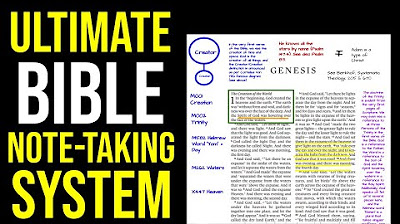Genius! Puritan Notetaking System
Summary
TLDRIn this video, Matthew introduces the genius of Jonathan Edwards' old Puritan note-taking system, which was designed to organize vast amounts of information without the aid of modern technology. Edwards created a series of interconnected notebooks, including a 'miscellaneous' system for diverse topics, a 'notes on scripture' system, and a unique 'blank Bible' for cross-referencing and indexing. Matthew explores how Edwards' method allowed for deep integration of ideas and efficient retrieval, drawing parallels to modern digital systems while also offering a personal account of how he's adopted similar methods in his own note-taking.
Takeaways
- 😀 Edwards' note-taking system is a highly structured, multi-layered approach for organizing ideas on a wide range of topics, including theology, philosophy, and church history.
- 😀 Edwards' system included multiple types of notebooks: miscellaneous notebooks for general topics, notes on scripture, and a 'blank Bible' for detailed commentary on the biblical text.
- 😀 The 'miscellaneous' notebooks were numbered, and each entry had a brief description in an index for easy cross-referencing, allowing Edwards to organize his thoughts without a computer or searchable database.
- 😀 The 'notes on scripture' notebooks were also numbered, specifically for insights on biblical passages, though not necessarily in canonical order, and would often reference other notebooks.
- 😀 The 'blank Bible' was a unique, specially designed Bible in which Edwards could write notes directly alongside the text, and these notes could reference other notebooks with specific numbers.
- 😀 Edwards used a cross-referencing method between his 'blank Bible' and other notebooks, linking concepts like justification or adoption across his entire note system, creating an interconnected web of ideas.
- 😀 Edwards' system extended beyond theology—he also created notebooks for controversies, philosophy, and even natural imagery, using the world around him to inspire spiritual insights.
- 😀 The beauty of Edwards' system was its flexibility: when one notebook filled up, he could simply add new ones and continue building his knowledge, much like a modern digital system.
- 😀 Modern practitioners can emulate Edwards' system by using blank Bibles, physical notebooks, or even digital tools to capture ideas in a similar layered, cross-referenced way.
- 😀 The integration of paper and digital tools can be combined in a modern version of Edwards' system, ensuring both the tactile and searchable aspects are utilized, making the system efficient and personal.
Q & A
What is the main purpose of Jonathan Edwards' note-taking system?
-The main purpose of Jonathan Edwards' note-taking system is to categorize and organize important information for future reference, allowing him to integrate various topics such as theology, philosophy, scripture, and natural observations into his work and sermons.
How did Edwards categorize his notes?
-Edwards categorized his notes into different types of notebooks. These included his 'Miscellaneous' notebook for general topics, 'Notes on Scripture' for Bible-related notes, and a 'Blank Bible' where he recorded notes alongside Bible passages. He also created specific notebooks for topics like 'Images of Divine Things' and 'Controversies'.
What is the 'Miscellaneous' notebook and how was it used?
-The 'Miscellaneous' notebook was a key part of Edwards' system where he recorded ideas on various topics, such as theology, philosophy, and scripture. Each note was numbered, and an index was created at the beginning of the notebook to track these entries. This allowed Edwards to easily locate notes by referencing the index later.
What role did the 'Blank Bible' play in Edwards' system?
-The 'Blank Bible' served as a central repository where Edwards recorded notes on the Bible. It had the entire text of the Bible with blank pages inserted for notes. These notes were cross-referenced with his other notebooks, allowing him to integrate insights from his miscellaneous notes and scripture notes directly into his Bible.
How did Edwards cross-reference his notes?
-Edwards used a numbering system to cross-reference his notes. For example, if he wrote a note on 'justification by faith' in his 'Miscellaneous' notebook (entry #1), he could reference that entry in his 'Blank Bible' when discussing relevant scripture, allowing him to link his thoughts and ideas across different notebooks.
What was the purpose of the 'Images of Divine Things' notebook?
-The 'Images of Divine Things' notebook was where Edwards recorded spiritual insights he derived from observing the natural world. For instance, he saw spiritual significance in things like a rose, a baby crying, or a rooster crowing, using these as metaphors or illustrations for divine truths.
Why did Edwards’ system include so many different notebooks?
-Edwards used different notebooks to organize and manage the diverse topics he worked on. Each notebook served a specific purpose, such as a theology-focused notebook, a scripture notebook, or one for natural observations, allowing him to maintain a highly organized, cross-referenced system for easy access and integration of his ideas.
What are the benefits of Edwards’ layered note-taking system?
-The benefits of Edwards’ layered system include better organization, easy retrieval of notes, and the ability to integrate ideas from various sources. His approach allowed him to combine his thoughts on scripture, theology, philosophy, and the natural world in a way that made it easy to reference and apply them to his sermons, treatises, and other writings.
How does Edwards' note-taking system compare to modern digital systems?
-Edwards' system is similar to modern digital systems in its use of cross-referencing and indexing, though it was entirely manual. While modern digital systems like Evernote or OneNote allow for easy tagging and searching, Edwards used physical notebooks with a numbering system and handwritten indices to achieve similar organizational results.
Can the Edwardsian system be adapted for modern use?
-Yes, the Edwardsian system can be adapted for modern use. While Edwards used handwritten notebooks, the concept of organizing notes by theme, number, and cross-referencing can be easily implemented in digital formats, allowing for a combination of digital and analog note-taking depending on personal preference.
Outlines

此内容仅限付费用户访问。 请升级后访问。
立即升级Mindmap

此内容仅限付费用户访问。 请升级后访问。
立即升级Keywords

此内容仅限付费用户访问。 请升级后访问。
立即升级Highlights

此内容仅限付费用户访问。 请升级后访问。
立即升级Transcripts

此内容仅限付费用户访问。 请升级后访问。
立即升级5.0 / 5 (0 votes)






